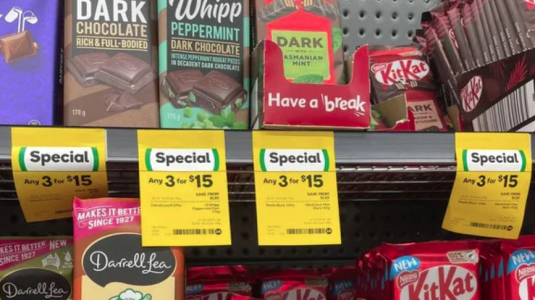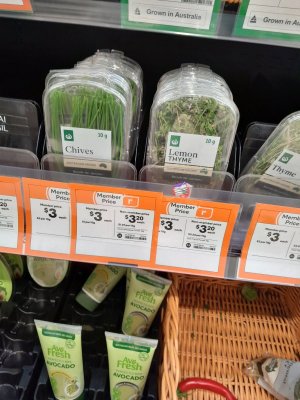Shoppers criticise supermarkets’ deceptive multi-buy tactics: 'This needs to stop'
By
VanessaC
- Replies 19
As Australians navigate the aisles of their local supermarkets, many are becoming increasingly aware of the marketing tactics used to encourage them to spend more.
A recent outcry from shoppers has brought to light one cunning tactic employed by these retail giants that could be costing shoppers more than they realise.
The controversy began when a customer noticed an unusually high number of multi-buy special offers during their weekly shop at Woolworths.
A photo of the chocolate aisle, featuring a deal enticing shoppers to buy three chocolate bars for $15, quickly sparked a heated discussion on social media.
The catch? Each chocolate bar was individually priced between $5.50 and $6, making the 'special' offer a mere saving of $1.50 at best.

'Excessive multi-buys, this is as bad as it gets,' the original poster wrote.
'I know it’s been happening for a while, but there really needs to be a massive boycott on engagement of these “specials”, this needs to stop.'
The conversation soon turned to the Australian Competition and Consumer Commission’s (ACCC) supermarket sector inquiry, which began this year.
This is the first investigation into the competitiveness of retail prices and allegations of price gouging since 2008, following widespread criticism of the sector from consumers, farmers, and the government.
Professor Nitika Garg from the University of New South Wales Business School explained the consumer psychology behind these multi-buy strategies.
'When people see a deal, they get more tempted, and they feel like they have been clever. There are lots of factors psychologically that play a role,' the professor said.
'It is a bit like securing a deal, every time we get a deal or we feel like we’ve sort of scored a good bargain, we get a dopamine rush.’
'So psychologically, it is very satisfying.'
However, Professor Garg warned that the actual savings might be minimal when you look at the unit pricing.
'So consumers just need to be careful,' she advised.
'Compare the unit price. How much are you actually saving in dollar amount?'
'A lot of times it might turn out that you’re not saving that much, and that will sort of stop the consumer in their tracks and make them rethink whether or not they want to buy, because a lot of times you just see the red sticker or yellow sticker and think “yes”.'
'Multi-buys are just a good strategy for supermarkets, and sometimes retailers rely on them, especially if they want to move stock.'
While supermarket tactics are certainly a factor, they're not the only reason for the increasing cost of chocolate.
According to Rabobank’s podcast, Sweet Inflation and the Chocolate Factory, retail prices of chocolate have steadily increased in the last two years due to surging manufacturing costs.
RaboResearch Associate Analyst Pia Piggott explained that cocoa prices have been on the rise as 'we head into a third year of cocoa deficit' globally.
'Retail chocolate market details indicate chocolate prices have gone up about 10.3 per cent in the last year,' she explained.
'Inflation in the confectionery and snacks category was up 6.8 per cent for the fourth quarter, but chocolate prices are rising faster than other items.'
Supply issues in West Africa, a major cocoa-producing region, are largely responsible for these higher prices.
The region is reportedly grappling with flooding, pest problems, and diseases in the cocoa trees.
'Raw material prices will be affecting chocolate providers. New York cocoa (market) prices are up 144 per cent from this time last year, and they are continually reaching new heights,' Ms Piggott added.
'Hopefully, by quarter two, we should get more information regarding production forecasts in West Africa. If these are positive, prices should moderate.'
'Otherwise, the high prices will likely cause some demand destruction which should also moderate the prices, but they will still remain historically high as supplies cannot increase quickly.'
 What are your thoughts on these supermarket tactics? Have you ever fallen for a 'special offer' that wasn't so special after all? Share your thoughts and experiences in the comments below.
What are your thoughts on these supermarket tactics? Have you ever fallen for a 'special offer' that wasn't so special after all? Share your thoughts and experiences in the comments below.
A recent outcry from shoppers has brought to light one cunning tactic employed by these retail giants that could be costing shoppers more than they realise.
The controversy began when a customer noticed an unusually high number of multi-buy special offers during their weekly shop at Woolworths.
A photo of the chocolate aisle, featuring a deal enticing shoppers to buy three chocolate bars for $15, quickly sparked a heated discussion on social media.
The catch? Each chocolate bar was individually priced between $5.50 and $6, making the 'special' offer a mere saving of $1.50 at best.

A customer pointed out a 'special' offer that did not really lead to significant savings. Image source: Reddit.
'Excessive multi-buys, this is as bad as it gets,' the original poster wrote.
'I know it’s been happening for a while, but there really needs to be a massive boycott on engagement of these “specials”, this needs to stop.'
The conversation soon turned to the Australian Competition and Consumer Commission’s (ACCC) supermarket sector inquiry, which began this year.
This is the first investigation into the competitiveness of retail prices and allegations of price gouging since 2008, following widespread criticism of the sector from consumers, farmers, and the government.
Professor Nitika Garg from the University of New South Wales Business School explained the consumer psychology behind these multi-buy strategies.
'When people see a deal, they get more tempted, and they feel like they have been clever. There are lots of factors psychologically that play a role,' the professor said.
'It is a bit like securing a deal, every time we get a deal or we feel like we’ve sort of scored a good bargain, we get a dopamine rush.’
'So psychologically, it is very satisfying.'
However, Professor Garg warned that the actual savings might be minimal when you look at the unit pricing.
'So consumers just need to be careful,' she advised.
'Compare the unit price. How much are you actually saving in dollar amount?'
'A lot of times it might turn out that you’re not saving that much, and that will sort of stop the consumer in their tracks and make them rethink whether or not they want to buy, because a lot of times you just see the red sticker or yellow sticker and think “yes”.'
'Multi-buys are just a good strategy for supermarkets, and sometimes retailers rely on them, especially if they want to move stock.'
While supermarket tactics are certainly a factor, they're not the only reason for the increasing cost of chocolate.
According to Rabobank’s podcast, Sweet Inflation and the Chocolate Factory, retail prices of chocolate have steadily increased in the last two years due to surging manufacturing costs.
RaboResearch Associate Analyst Pia Piggott explained that cocoa prices have been on the rise as 'we head into a third year of cocoa deficit' globally.
'Retail chocolate market details indicate chocolate prices have gone up about 10.3 per cent in the last year,' she explained.
'Inflation in the confectionery and snacks category was up 6.8 per cent for the fourth quarter, but chocolate prices are rising faster than other items.'
Supply issues in West Africa, a major cocoa-producing region, are largely responsible for these higher prices.
The region is reportedly grappling with flooding, pest problems, and diseases in the cocoa trees.
'Raw material prices will be affecting chocolate providers. New York cocoa (market) prices are up 144 per cent from this time last year, and they are continually reaching new heights,' Ms Piggott added.
'Hopefully, by quarter two, we should get more information regarding production forecasts in West Africa. If these are positive, prices should moderate.'
'Otherwise, the high prices will likely cause some demand destruction which should also moderate the prices, but they will still remain historically high as supplies cannot increase quickly.'
Key Takeaways
- Shoppers have criticised supermarket multi-buy special options as 'trickery' amid a government inquiry into the sector.
- A social media post showing a Woolworths chocolate aisle promotion offered three bars for $15 when each was priced at about $5.50 and $6, questioning the value of such deals.
- The Australian Competition and Consumer Commission (ACCC) is conducting a 12-month inquiry into retail price competitiveness and allegations of price gouging.
- Experts suggested customers compare unit prices to determine real savings, and RaboResearch notes chocolate prices have risen due to rising cocoa costs and supply issues from West Africa.








